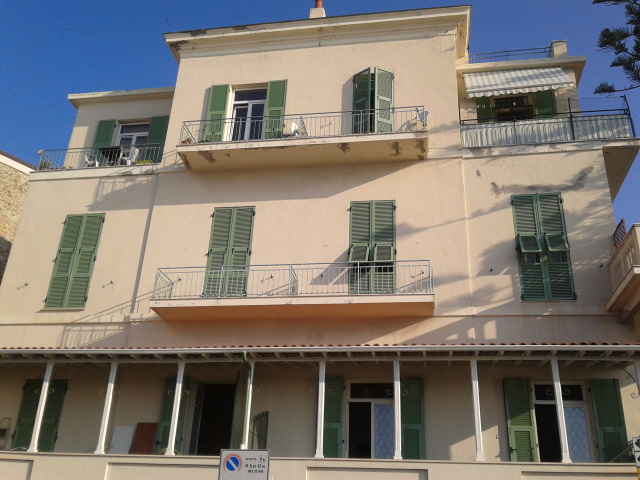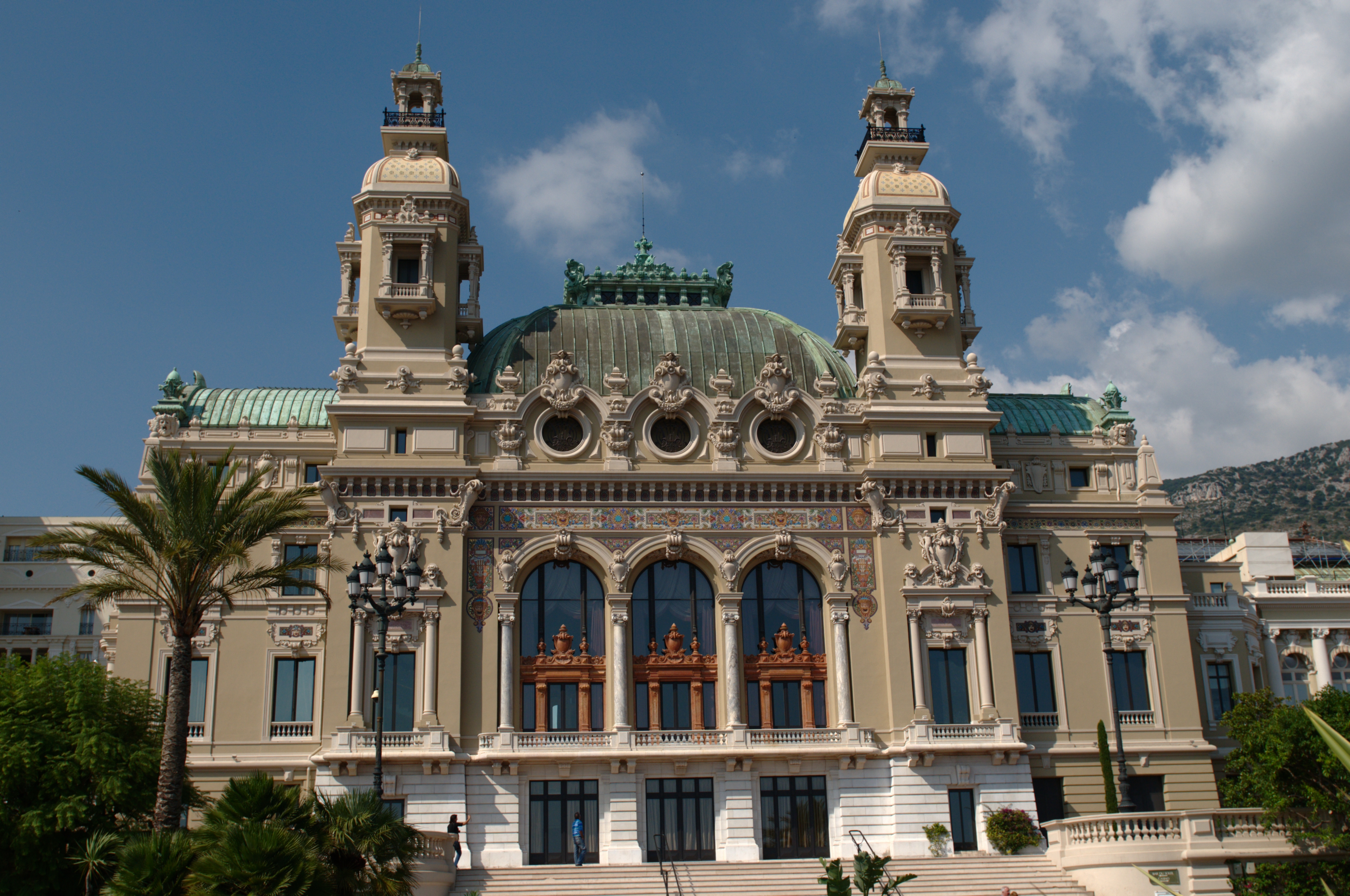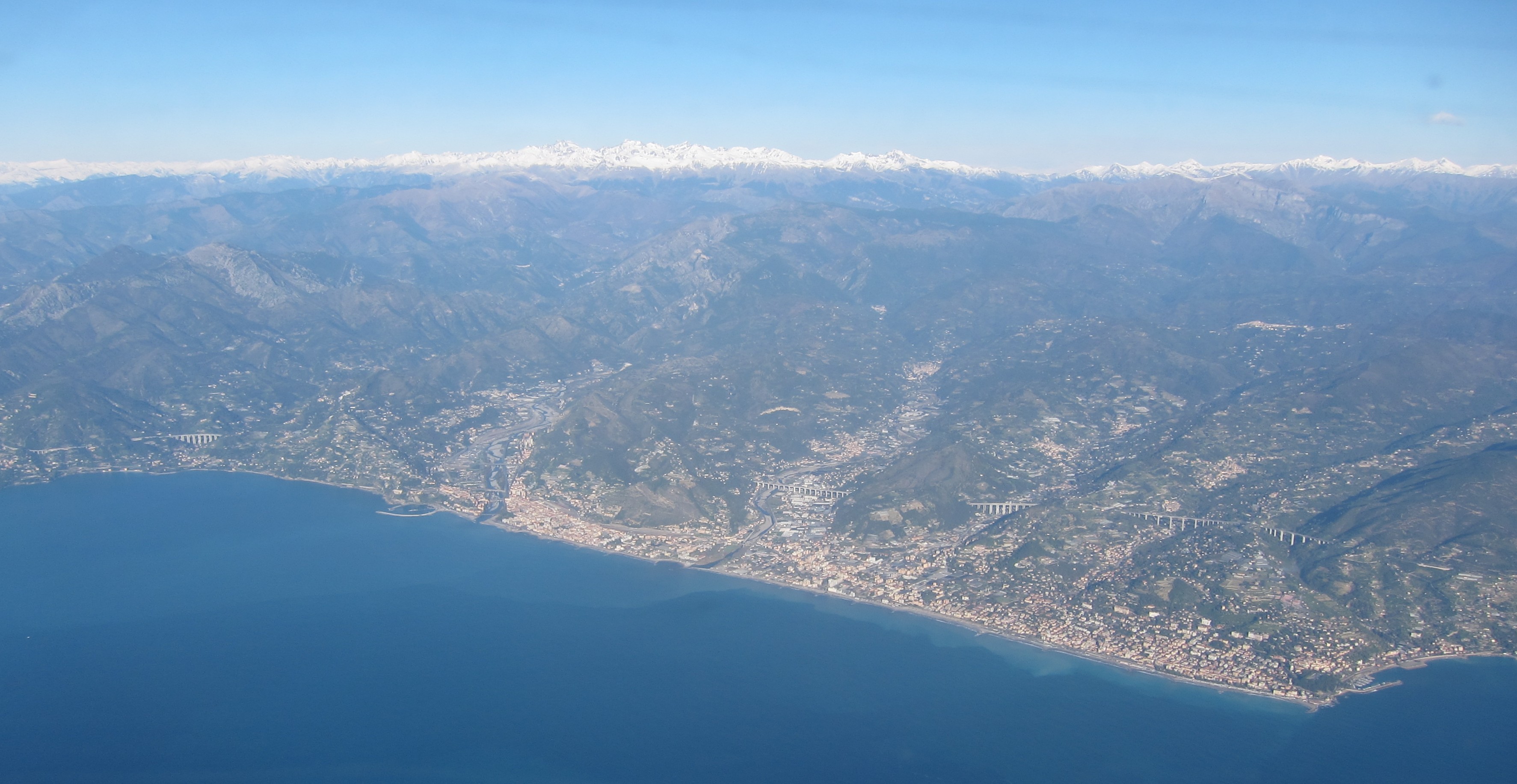|
Friederich Von Kleudgen
Baron Friedrich von Kleudgen, sometimes known by his nickname Fritz, was born in Germany and studied painting in Weimar. He later moved to the Academy of Art Dresden where he met Adrian Ludwig Richter. Like many artists of his time, he visited Italy, with extended stays in Naples and Venice. In 1873 he arrived in Bordighera with his wife and stayed at the Pensione Calvauna, which later became Coffee Cadama, until 1884. In the city he found a small German community and fascinated by the climate and light, decided to settle in the Ligurian town. In 1885 he built his home just outside the walls of old Bordighera, near the port of Magdalena and the old cemetery. The house, which he named "Villa Banana", and that is on the 4th of Via dei Colli, still exists today but unfortunately it was turned into an apartment building and is in poor conditions. In 1891 he married his second wife, Elizabeth Pudmensky. They had three children: Frieda, William (mountaineer who died in 1929) and Luise ... [...More Info...] [...Related Items...] OR: [Wikipedia] [Google] [Baidu] |
Würzburg
Würzburg (; Main-Franconian: ) is a city in the region of Franconia in the north of the German state of Bavaria. Würzburg is the administrative seat of the ''Regierungsbezirk'' Lower Franconia. It spans the banks of the Main River. Würzburg is situated approximately east-southeast of Frankfurt am Main and approximately west-northwest of Nuremberg (). The population (as of 2019) is approximately 130,000 residents. The administration of the ''Landkreis Würzburg'' ( district of Würzburg) is also located in the town. The regional dialect is East Franconian. History Early and medieval history A Bronze Age (Urnfield culture) refuge castle, the Celtic Segodunum,Koch, John T. (2020)CELTO-GERMANIC Later Prehistory and Post-Proto-Indo-European vocabulary in the North and West p. 131 and later a Roman fort, stood on the hill known as the Leistenberg, the site of the present Fortress Marienberg. The former Celtic territory was settled by the Alamanni in the 4th or 5th century ... [...More Info...] [...Related Items...] OR: [Wikipedia] [Google] [Baidu] |
Hermann Nestel
Herman Nestel (1858-1905) was a German painter. Biography Hermann Nestel was born in Stuttgart and, from an early age, showed a particular aptitude for the arts. He began his artistic training in his hometown and then moved to Munich and Berlin. Like many artists of the time, he made his trip to Italy to complete his training. In 1882 he was commissioned by the German Wilhelm Spemann to illustrate the Ligurian and French coasts, from Nice to La Spezia. The drawings of Nestel were used to illustrate the book "Die Riviera", written by Woldemar Kaden. In 1887 he decided to settle in Bordighera. There, he met the botanist and landscape architect Ludwig Winter with whom he became friend. In Bordighera, he continued to collaborate with German publishers, in particular with the magazines "Gartenlaube" and "Über Land und Meer". In Bordighera, one of Nestel's daughters married Antonio, the first-born of Ludwig Winter. Nestel then began a collaboration with Winter in the creation of ... [...More Info...] [...Related Items...] OR: [Wikipedia] [Google] [Baidu] |
German Male Painters
German(s) may refer to: * Germany (of or related to) **Germania (historical use) * Germans, citizens of Germany, people of German ancestry, or native speakers of the German language ** For citizens of Germany, see also German nationality law **Germanic peoples (Roman times) * German language **any of the Germanic languages * German cuisine, traditional foods of Germany People * German (given name) * German (surname) * Germán, a Spanish name Places * German (parish), Isle of Man * German, Albania, or Gërmej * German, Bulgaria * German, Iran * German, North Macedonia * German, New York, U.S. * Agios Germanos, Greece Other uses * German (mythology), a South Slavic mythological being * Germans (band), a Canadian rock band * "German" (song), a 2019 song by No Money Enterprise * ''The German'', a 2008 short film * "The Germans", an episode of ''Fawlty Towers'' * ''The German'', a nickname for Congolese rebel André Kisase Ngandu See also * Germanic (other) * Germa ... [...More Info...] [...Related Items...] OR: [Wikipedia] [Google] [Baidu] |
19th-century German Male Artists
The 19th (nineteenth) century began on 1 January 1801 ( MDCCCI), and ended on 31 December 1900 ( MCM). The 19th century was the ninth century of the 2nd millennium. The 19th century was characterized by vast social upheaval. Slavery was abolished in much of Europe and the Americas. The First Industrial Revolution, though it began in the late 18th century, expanding beyond its British homeland for the first time during this century, particularly remaking the economies and societies of the Low Countries, the Rhineland, Northern Italy, and the Northeastern United States. A few decades later, the Second Industrial Revolution led to ever more massive urbanization and much higher levels of productivity, profit, and prosperity, a pattern that continued into the 20th century. The Islamic gunpowder empires fell into decline and European imperialism brought much of South Asia, Southeast Asia, and almost all of Africa under colonial rule. It was also marked by the collapse of the large S ... [...More Info...] [...Related Items...] OR: [Wikipedia] [Google] [Baidu] |
19th-century German Painters
The 19th (nineteenth) century began on 1 January 1801 ( MDCCCI), and ended on 31 December 1900 ( MCM). The 19th century was the ninth century of the 2nd millennium. The 19th century was characterized by vast social upheaval. Slavery was abolished in much of Europe and the Americas. The First Industrial Revolution, though it began in the late 18th century, expanding beyond its British homeland for the first time during this century, particularly remaking the economies and societies of the Low Countries, the Rhineland, Northern Italy, and the Northeastern United States. A few decades later, the Second Industrial Revolution led to ever more massive urbanization and much higher levels of productivity, profit, and prosperity, a pattern that continued into the 20th century. The Islamic gunpowder empires fell into decline and European imperialism brought much of South Asia, Southeast Asia, and almost all of Africa under colonial rule. It was also marked by the collapse of the large S ... [...More Info...] [...Related Items...] OR: [Wikipedia] [Google] [Baidu] |
Villa Garnier
Villa Garnier is a building in Bordighera in western Italy. Villa Garnier and Villa Amica are part of the properties protected by the Superintendent of Ministry of Cultural Heritage and Activities and Tourism (Italy). The villa is located 11 Garnier Street in Bordighera on the Italian Riviera. History In 1871 Charles Garnier (architect) left Paris and the building site of the Opera which was blocked due to the war with Prussia and the Paris Commune. The family moved to Menton hometown of his wife, Louise Bary and, visiting the surroundings, they discover Bordighera. Back in May 1871 Garnier chose a plot near the Arziglia, where to build his villa. Unfortunately, the land was already occupied by an old chapel dedicated to St. Sebastian, but which had been desecrated since serving as a school for boys in the country. The land was located outside the walls of the old town, down to the sea and next to fishermen beach, the famous Arziglia. To get the coveted land, Garnier decided to o ... [...More Info...] [...Related Items...] OR: [Wikipedia] [Google] [Baidu] |
Claude Monet
Oscar-Claude Monet (, , ; 14 November 1840 – 5 December 1926) was a French painter and founder of impressionist painting who is seen as a key precursor to modernism, especially in his attempts to paint nature as he perceived it. During his long career, he was the most consistent and prolific practitioner of impressionism's philosophy of expressing one's perceptions before nature, especially as applied to ''plein air'' (outdoor) landscape painting. The term "Impressionism" is derived from the title of his painting '' Impression, soleil levant'', exhibited in the 1874 ("exhibition of rejects") initiated by Monet and his associates as an alternative to the Salon. Monet was raised in Le Havre, Normandy, and became interested in the outdoors and drawing from an early age. Although his mother, Louise-Justine Aubrée Monet, supported his ambitions to be a painter, his father, Claude-Adolphe, disapproved and wanted him to pursue a career in business. He was very close to his mot ... [...More Info...] [...Related Items...] OR: [Wikipedia] [Google] [Baidu] |
Ludwig Winter
Ludwig Winter (August 9, 1846 – July 12, 1912) was a German botanist, nurseryman and landscape designer, creator of gardens such as the Giardini Botanici Hanbury, noted for introducing tall palms and other foreign species to the Ligurian riviera. Biography Born in Kingdom of Prussia, Prussia, the son of a bookseller, the family moved to Leipzig where he studied botany and became a gardener at Erfurt. After two years at Erfurt he went to the School of Horticulture in Potsdam, graduating in Botanics, and then became head gardener at the Botanische Gärten der Friedrich-Wilhelms-Universität Bonn, Botanical Garden of Poppelsdorf near Bonn. In 1867 he went to the Exposition Universelle (1867), Paris World Exposition and settled there, working first as a labourer and then as head gardener in the Tuileries Garden. As the Franco-Prussian War approached, the increasingly tense atmosphere in Paris forced Winter to move south via Marseilles and Cannes to Hyères in the Côte d'Azur, wh ... [...More Info...] [...Related Items...] OR: [Wikipedia] [Google] [Baidu] |
Charles Garnier (architect)
Jean-Louis Charles Garnier (; 6 November 1825 – 3 August 1898) was a French architect, perhaps best known as the architect of the Palais Garnier and the Opéra de Monte-Carlo. Early life Charles Garnier was born Jean-Louis Charles Garnier on 6 November 1825 in Paris, on the Rue Mouffetard, in the present-day 5th arrondissement. His father, Jean" André Garnier, 1796–1865, who was originally from Sarthe, a department of the French region of Pays de la Loire, had worked as a blacksmith, wheelwright, and coachbuilder before settling down in Paris to work in a horse-drawn carriage rental business. He married Felicia Colle, daughter of a captain in the French Army. Later in life Garnier would all but ignore the fact that he was born of humble origins, preferring to claim Sarthe as his birthplace. Education Garnier became an apprentice of Louis-Hippolyte Lebas, and after that a full-time student of the École royale des Beaux-Arts de Paris, beginning during 1842. He obtained ... [...More Info...] [...Related Items...] OR: [Wikipedia] [Google] [Baidu] |
Giuseppe Ferdinando Piana
Giuseppe Ferdinando Piana (3 December 1864 - 29 April 1956) was an Italian painter. Life and career Piana shows from an early age a strong aptitude for painting. It was Ernest Meissonier who, during one of his stays in Bordighera at Villa Garnier, recommended to his parents to make him study arts. In 1882 Giuseppe Ferdinando Piana moved to Turin to study all' Albertina Academy where he had as professors Francesco Gamba and Andrea Gastaldi. It is in Turin that he made his first paintings: "A ponenete di Bordighera, campagna ligure", "Politica rustica" and in 1898 "Studio d'artista" that will be purchased by the government. In 1903 he moved to Sesto San Giovanni, he exhibited at the Permanent show in Milan where he presented "Peace", which received unexpected praise. In 1906 he was invited to the National exhibition in Milan where he presented "Cortile dei leoni a Granada", "La danza delle olive" and "Mare dopo la pioggia". The latter two paintings were purchased by the Galler ... [...More Info...] [...Related Items...] OR: [Wikipedia] [Google] [Baidu] |
Bordighera
Bordighera (; lij, A Bordighea, locally ) is a town and ''comune'' in the Province of Imperia, Liguria (Italy). Geography Bordighera is located from the land border between Italy and France, and it is possible to see the French coast with a naked eye from the town. Having the "Capo Sant’Ampelio" which protrudes into the sea, it is the southernmost commune of the region. The cape is at around the same latitude as Pisa and features a little church built in the 11th century for Sant’Ampelio, the patron saint of the city. Since Bordighera is built where the Maritime Alps plunge into the sea, it benefits from the Foehn effect which creates a special microclimate that has warmer winters. History It seems that Bordighera has been inhabited since the Palaeolithic era, as archaeologists have found signs of human activities in the caves along the Italian and French coast. In the 6th century BC came the Ligures, from whom the name of the region, "Liguria" in Italian, is derived. They w ... [...More Info...] [...Related Items...] OR: [Wikipedia] [Google] [Baidu] |
Pompeo Mariani
Pompeo Mariani (9 September 1857, Monza – 25 January 1927, Bordighera) was an Italian painter. Biography Mariani was born in Monza, Province of Milan. The nephew of the painter Mosè Bianchi, he abandoned a career in banking to devote himself entirely to painting. His apprenticeship began in 1879 under the guidance of the painter Eleuterio Pagliano, who introduced him to life studies. A trip to Egypt with Uberto Dell’Orto in 1881 provided subjects for the works shown at the Brera exhibitions of the next two years. He focused on landscape painting and began to specialise in seascapes in 1883, when he first stayed on the coast of Liguria. The first views of the Zelata area outside Pavia appeared in 1894. His art is characterised by subtle sensitivity in the investigation of the reflection of light on water, captured in different seasons and times of the day to achieve highly atmospheric effects. It was at the beginning of the new century that he began to combine naturalistic la ... [...More Info...] [...Related Items...] OR: [Wikipedia] [Google] [Baidu] |





